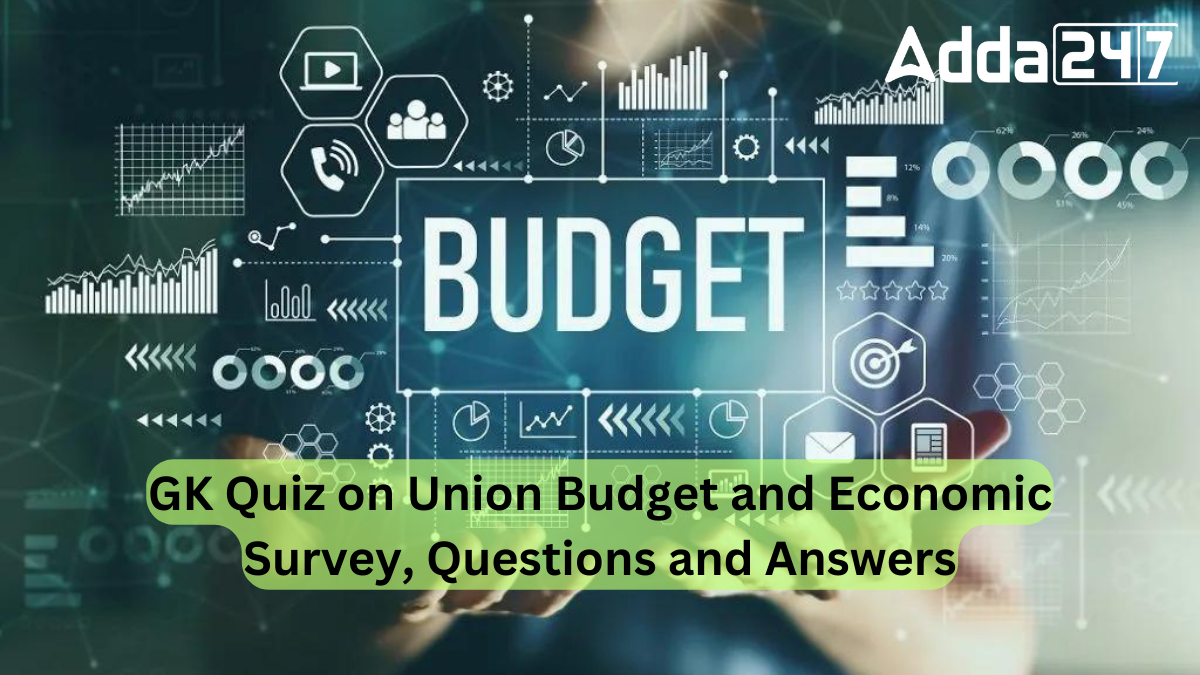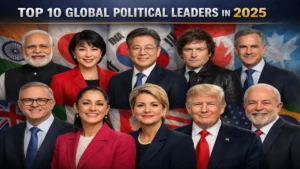The Union Budget and Economic Survey of India are pivotal documents that shape the country’s fiscal policies and economic trajectory. The Union Budget, presented annually by the Finance Minister, outlines the government’s revenue and expenditure plans for the upcoming fiscal year, influencing various sectors and industries. On the other hand, the Economic Survey provides a comprehensive analysis of India’s economic performance, challenges, and policy recommendations, offering insights crucial for informed decision-making and understanding the nation’s economic health.
GK Quiz on Union Budget and Economic Budget
Test your understanding of the Union Budget and Economic Survey of India through the General Knowledge (GK) quiz related to Union Budget and Economic Survey. These annual documents are crucial for understanding the fiscal and economic policies of the Indian government. Let’s see how well you know about them!
Q1.Which of the following is not a component of government budget?
A) Revenue Budget
B) Capital Budget
C) Surplus Budget
D) None of the above
S1. Ans. (C)
Q2. What is the term for the difference between government’s total receipts (excluding borrowing) and total expenditure called?
A) Fiscal Deficit
B) Revenue Deficit
C) Primary Deficit
D) Budgetary Deficit
S2. Ans. (A)
Q3. Which of the following accurately describes a Budget?
I. It serves as a projection of financial activities for an upcoming period, outlining planned spending and methods for funding it.
II. Article 111 of the Constitution mandates that the government must submit to Parliament an outline of anticipated income and expenses for each fiscal year.
A) Only I
B) Only II
C) Both I and II
D) None of the above
S3. Ans. (A)
Q4. Which of the following statements accurately pertain to the annual financial statement (Budget)?
I. The annual financial statement is segmented into three sections: consolidated fund, contingency fund, and public account.
II. All government revenues generated, borrowed funds, and proceeds from loans extended by the government are channeled into the consolidated fund of India.
III. Article 112 of the Constitution mandates that the government must provide Parliament with an outline of projected income and expenditure for each fiscal year.
Options:
A) Only I and II
B) Only II and III
C) All of the Above
D) None of the above
S4. Ans. (D)
Q5. Which of the following statements accurately describes the concepts of budget, budgeting, and budgetary control?
I. Budget entails the formulation of business estimates.
II. Budgetary control serves as a mechanism to attain performance objectives outlined in the budget.
Options:
A) Only I
B) Only II
C) Both I and II
D) None of the above
S5. Ans. (B)
Q6. Which of the following statements accurately distinguishes between budget, budgeting, and budgetary control?
I. Budgetary control encompasses broader aspects compared to Budget and budgeting, which are narrower in scope.
II. Budget involves the preparation of business estimates.
Which statement(s) is/are correct regarding budget, budgeting, and budgetary control?
Options:
A) Only I
B) Only II
C) Both I and II
D) None of the above
S6. Ans. (A)
Q7. What do you understand by the term “Fiscal Federalism”?
A) It signifies the transfer of authority and obligations among national, sub-national, and local governments.
B) It denotes the monetary interactions among governmental entities within a federal system.
C) It represents the disposable income households retain after deducting income taxes.
D) It posits that as per capita income surpasses a certain threshold, population tends to rise.
S7. Ans. (B)
Q8. Identify the incorrect phase of the budget process in India.
A) Budget formulation: creating estimates of expenditure and revenue for the upcoming fiscal year.
B) Budget enactment: the Legislature’s endorsement of the proposed Budget via the enactment of Finance Bill and Appropriation Bill.
C) Budget execution: implementing the provisions outlined in the Finance Act and Appropriation Act by the government, including revenue collection and expenditure allocation as authorized by the Legislature.
D) Judicial scrutiny of budget implementation: evaluations of government financial activities conducted on behalf of the Legislature.
S8. Ans. (D)
Q9. Who was the first finance minister of India?
A) John Mithai
B) C.D. Deshmukh
C) Shanmukhan Chetty
D) Liaquat Ali Khan
S9. Ans. (A)
Q10. Identify the correct definition of Capital payments.
A) It denotes capital expenditures on the construction of capital projects and procurement of assets such as land, buildings, machinery, and equipment.
B) It signifies capital revenue generated from the construction of capital projects and acquisition of assets such as land, buildings, machinery, and equipment.
C) It represents the expenditure allocated to the daily operations of the Government and its diverse departments, along with the services it delivers.
D) None of the options provided correctly define Capital payments.
S10. Ans. (A)
Q11. In which section of the Indian Constitution is the provision for the Union Budget mentioned?
A) Article 110
B) Article 268
C) Article 112
D) Article 356
S11. Ans. (C)
Q12. What is the main purpose of a government budget?
A) To control inflation
B) To manage public debt
C) To allocate resources efficiently
D) To increase government revenue
S12. Ans. (C)
Q13. Which of the following statements accurately describe Zero-Based Budgeting (ZBB)?
I. Zero-Based Budgeting was initially introduced in India during the Union Budget of 1987.
II. Zero-Based Budgeting entails the prioritization of all government expenditures.
III. Zero-Based Budgeting involves conducting a cost-benefit analysis of all programs, ensuring that those deemed most crucial remain operational if they are yielding positive results.
Which statement(s) among the options provided are correct?
Options:
A) Only I and II
B) Only II
C) Only III
D) All the above
S13. Ans. (A)
Q14. What distinguishes a ‘vote-on-account’ from an ‘interim budget’?
I. The utilization of a vote-on-account is customary for a functioning government, while an interim budget is typically employed by an interim or caretaker government.
II. A vote-on-account pertains solely to the government’s expenditure, whereas an interim budget encompasses both expenditure and receipts.
Which of the given statements accurately describes the difference between a ‘vote-on-account’ and an ‘interim budget’?
Options:
A) Only I
B) Only II
C) Both I and II
D) None of the above
S14. Ans. (C)
Q15. Regarding Indian Public Finance, which of the following statements are correct?
I. Disbursements from the Public Account of India are subject to the Vote of Parliament.
II. The Indian Constitution provides for the establishment of a Consolidated Fund, a Public Account, and a Contingency Fund for each State.
III. Appropriations and disbursements under the Railways Budget are subject to the same form of parliamentary control as other appropriations and disbursements.
A) I and II
B) II and III
C) I and III
D) I, II, and III
S15. Ans. (B)
Q16. Who authorizes the withdrawal of funds from the Consolidated Fund of India?
A) The President of India
B) The Parliament of India
C) The Prime Minister of India
D) The Union Finance Minister
S16. Ans. (B)
Q17. What happens if the Lok Sabha fails to pass the annual budget?
A) The Budget is modified and presented again.
B) The Budget is referred to the Rajya Sabha for suggestions.
C) The Union Finance Minister is asked to resign.
D) The Prime Minister submits the resignation of the Council of Ministers.
S17. Ans. (D)
Q18. When is the Vote on Account passed?
A) After the voting of demands
B) Before the general discussion
C) After the general discussion
D) Either after the voting of the demands or after the general discussion.
S18. Ans. (C)
Q19. Arrange the following stages in the enactment of the budget in the correct order:
I. General discussion
II. Appropriation Bill
III. Finance Bill
IV. Voting of the demands for grants
V. Presentation to the legislature
Options:
A) I, II, III, IV, V
B) V, I, II, III
C) V, I, IV, III, II
D) V, I, III, IV, II
S19. Ans. (B)
Q20. Which documents are presented to the legislature along with the budget?
I. An explanatory memorandum on the budget
II. A summary of demands for grants
III. An Appropriation Bill
IV. A Finance Bill
V. The Economic Survey
Code:
A) I, III, and V
B) I, II, and III
C) II, III, and V
D) I, II, III, and IV
S20. Ans. (D)
Q21. When was the budget formally introduced in India?
A) 1860
B) 1947
C) 1950
D) 1868
S21. Ans. (A)
Q22. Which statements about the Public Account of India are correct?
I. The public account is the fund to which all public money received by or on behalf of the government are credited.
II. No legislative appropriation is required for payments from the Public Account of India.
III. Legislative appropriation is required for payments from the Public Account of India.
IV. All public money, other than those credited to the Consolidated Fund of India, which are received by or on behalf of the government is credited to the Public Account of India.
V. It is operated by executive action.
Options:
A) I, II, and V
B) I, III, and V
C) II, IV, and V
D) II and IV
S22. Ans. (C)
Q23. Which statements about the Appropriation Bill and the Finance Bill are incorrect?
I. Appropriation Bill cannot be amended while the Finance Bill can be amended.
II. Finance Bill cannot be amended while Appropriation Bill can be amended.
III. Same procedure governs both the Appropriation Bill and the Finance Bill.
IV. Appropriation Bill and the Finance Bill are governed by different procedures.
V. Appropriation bill cannot be rejected by the Rajya Sabha while Finance Bill can be rejected by it.
Options:
A) II and IV
B) II, IV, and V
C) I and III
D) I, III, and V
S23. Ans. (B)
Q24. In the Constitution of India, the term ‘Budget’ is mentioned in which Article?
A) Art. 266
B) Art. 112
C) Art. 265
D) None
S24. Ans. (D)
Q25. Consider the following statements regarding Zero-Based Budgeting (ZBB):
I. Zero-Based Budgeting was initially introduced in India during the Union Budget of 1987.
II. Zero-Based Budgeting involves prioritizing all government expenditures.
III. It includes a cost-benefit analysis of all schemes, and those deemed most important are retained if they are functioning effectively.
Which of the statements above are accurate?
A) Statement I and II
B) Statement I and III
C) Statement II and III
D) All of the statements
S25. Ans. (A)




 Top 10 Most Popular Global Political Lea...
Top 10 Most Popular Global Political Lea...
 Which Lake is known as the Jewel of Kash...
Which Lake is known as the Jewel of Kash...
 Which Tree is known as the Bodhi Tree? K...
Which Tree is known as the Bodhi Tree? K...







